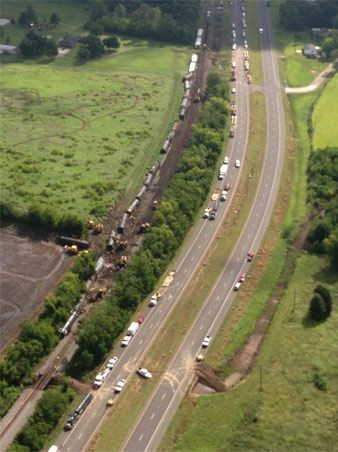Louisiana Train Derails: 100 Homes Evacuated, As Families Face Risk Of Sodium Hydroxide Poisoning

A 26-car train derailment in Louisiana has caused the evacuation of around 100 homes along U.S. 190 this past Sunday. According to Louisiana Gov. Bobby Jindal, the hazardous chemical sodium hydroxide was leaking from the wreckage and will close the highway for at least two days.
"Anytime you have chemicals leaking into the environment, that's a serious issue," Jindal explained. "Nobody knows the extent of the damage. We'll get that in the next 24 hours."
The 76-car train owned by Union Pacific went off the tracks in the small community of Lawtell, about 60 miles west of Baton Rouge, KATC reported. The train's only passengers were an engineer and a conductor who were left uninjured. One person was hospitalized due to complaints of eye irritation.
Master Trooper Daniel "Scott" Moreau said that one of the cars was leaking sodium hydroxide at the time of the crash and that authorities were working to clear the disaster. Luckily, the amount of chemicals that leaked out was so small it couldn't be picked up by air pollution detectors.
According to the Centers for Disease Control and Prevention, sodium hydroxide is a white, odorless solid that absorbs moisture from the air. This chemical can become combustible when combined with water. If a person's skin or clothing is contaminated by sodium hydroxide, he or she can easily share it by direct contact.
Although it is odorless, sodium hydroxide can lead to the irritation of the mucous membranes in the nose, throat, and respiratory tract when inhaled through dust, mist, or aerosol form. Exposure of the skin or eyes to the chemical could lead to deep-tissue burns.
A second car in the disaster was leaking lube oil and a third was carrying vinyl chloride that did not leak out. Inhalation of vinyl chloride can lead to dizziness, drowsiness, headaches, and giddiness, the Environmental Protection Agency reports.
"The cars that derailed include lube oil and other products. There was some vinyl chloride on there," said Union Pacific spokesperson Raquel Espinoza.
"We're going to go in there and assess the situation and do what we need to do to put the cars back on the track. A lot of times it takes us sometime because we want to make sure we keep the public safe."



























